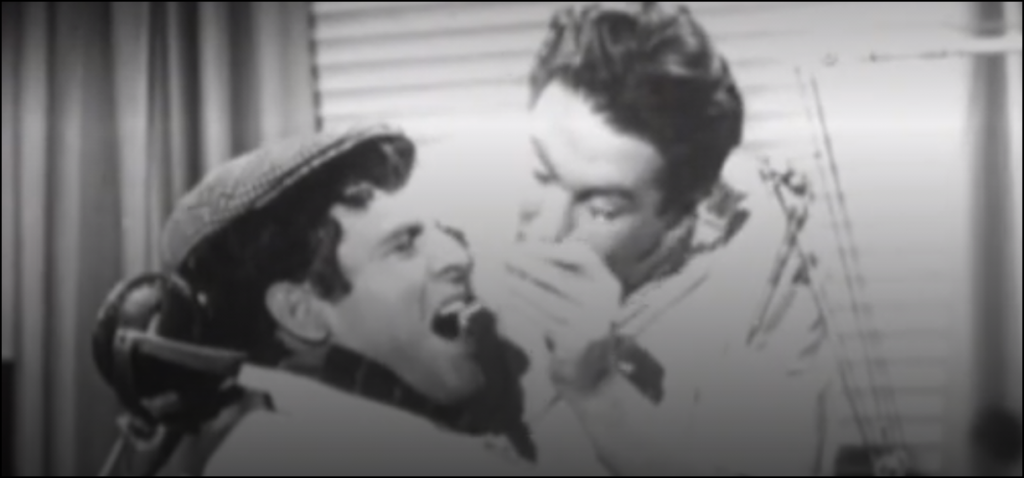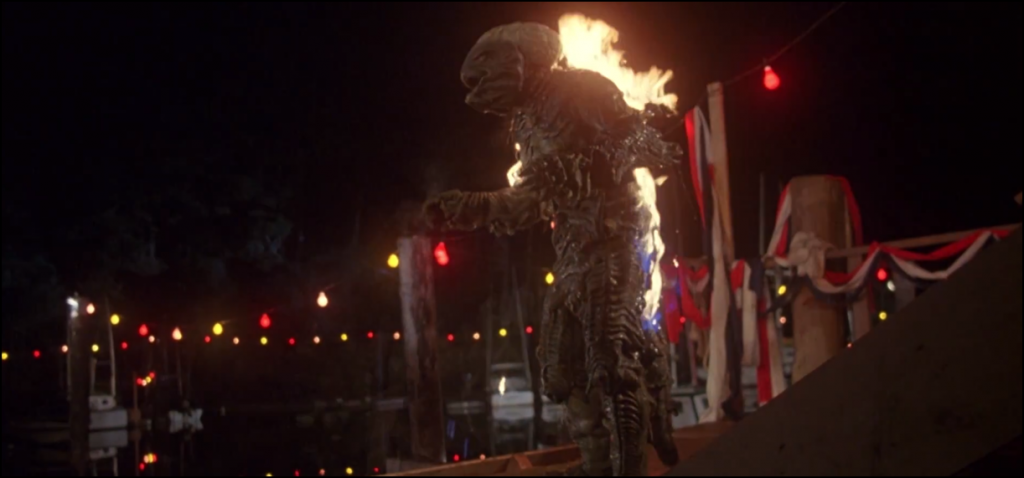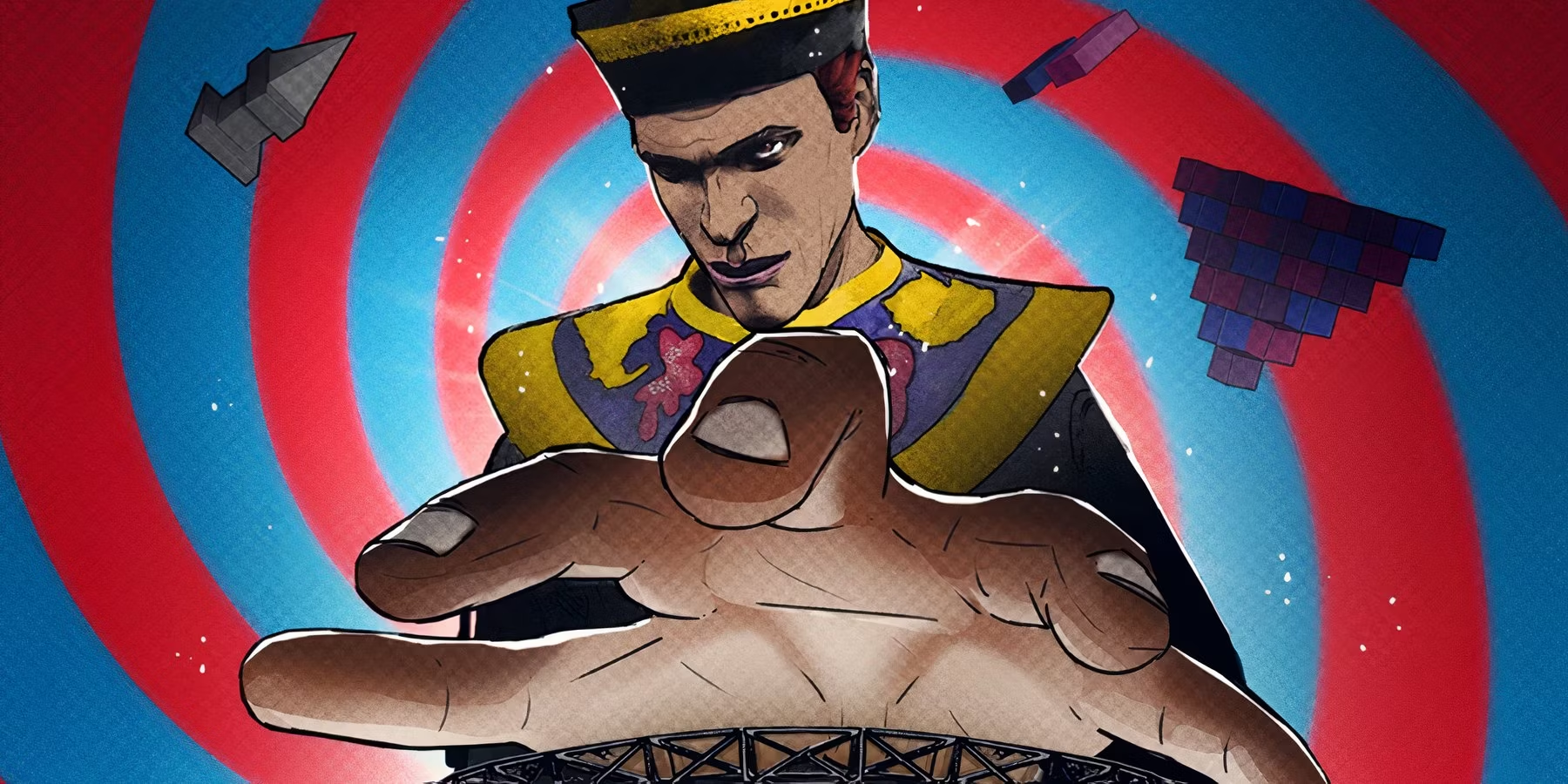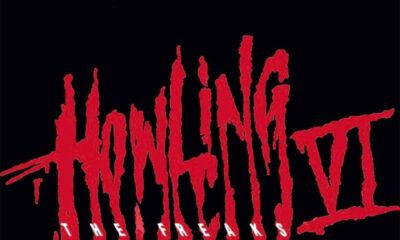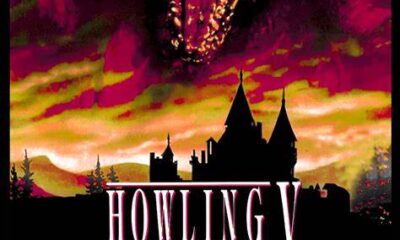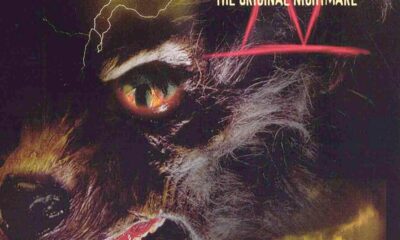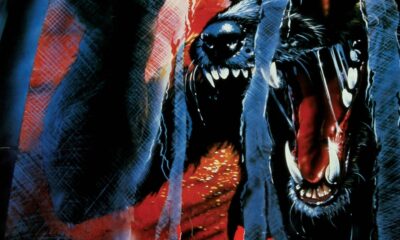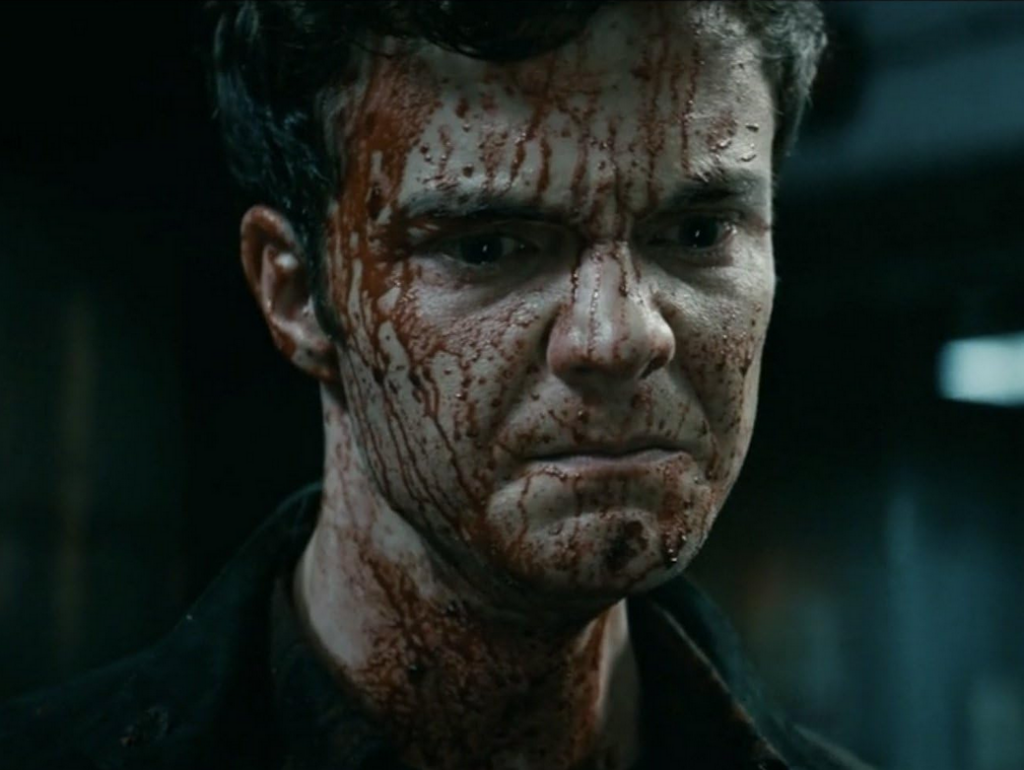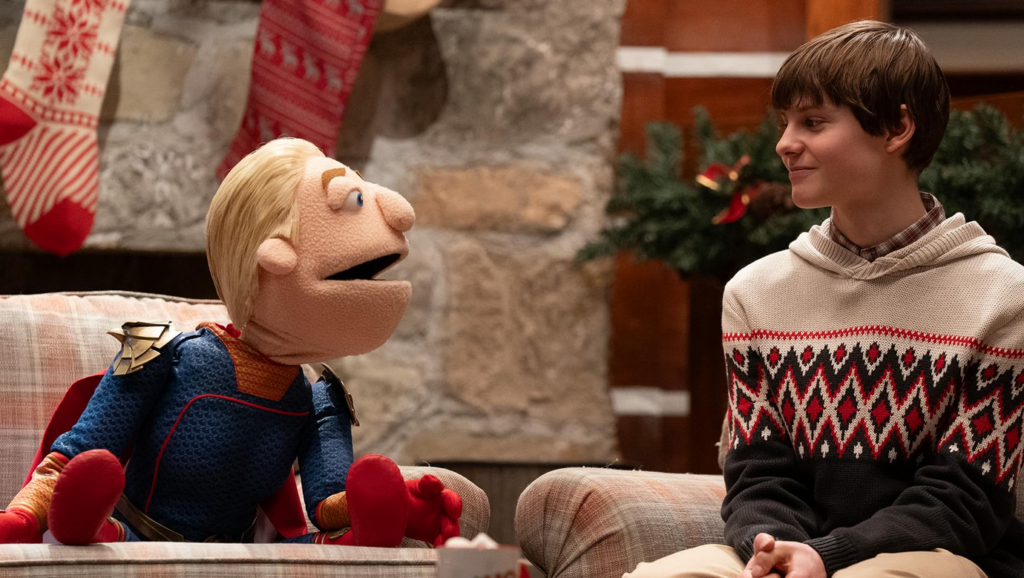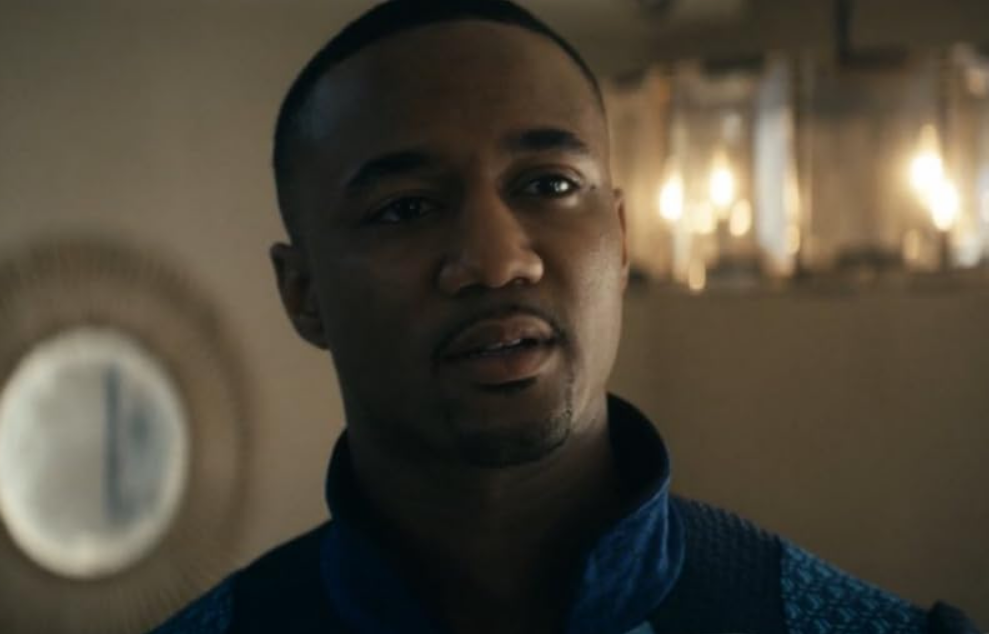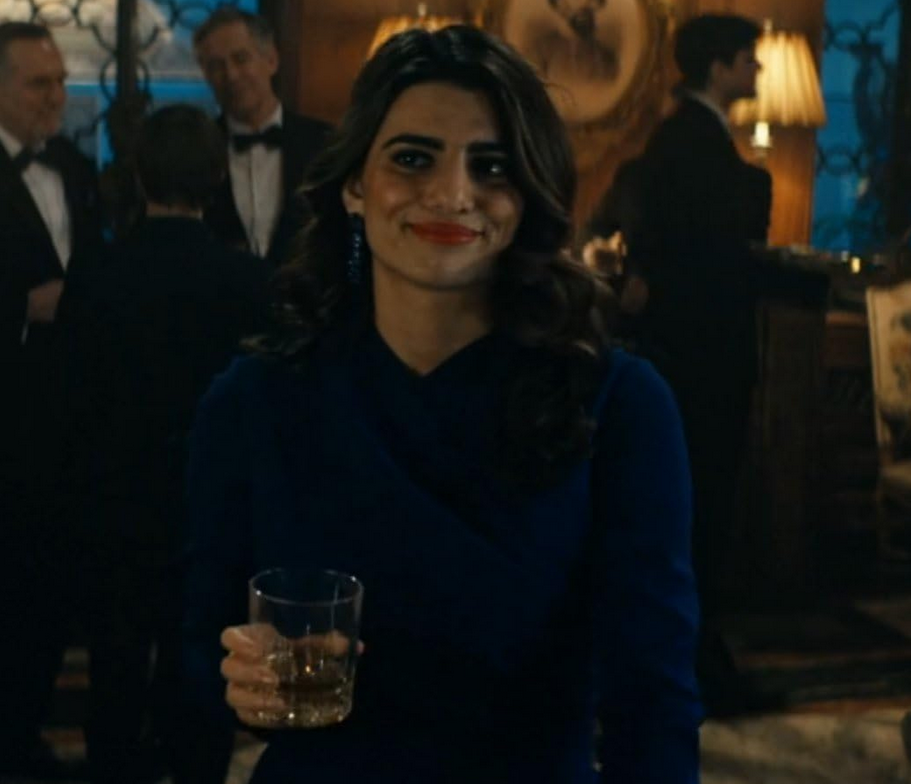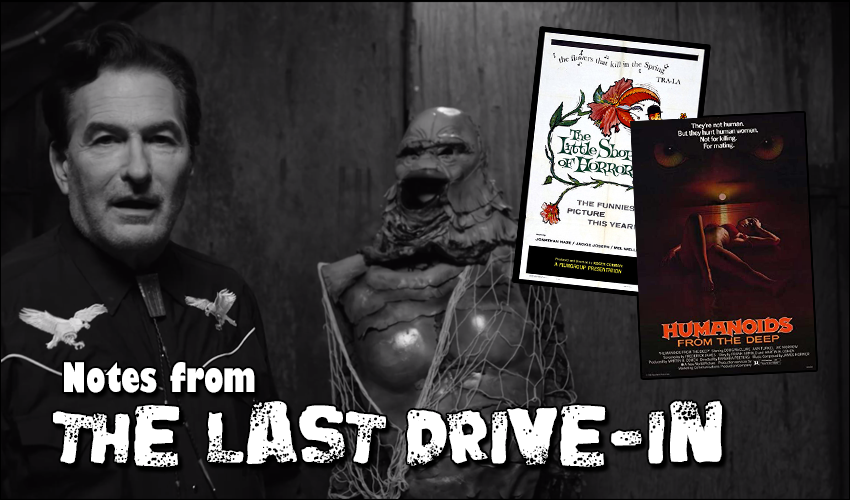
Notes from the Last Drive-In: S3E10 – The Little Shop of Horrors and Humanoids from the Deep
More Videos
Published
3 years agoon
Tonight a living legend (who isn’t Joe Bob Briggs) makes an appearance on the show as Roger Corman walks us through The Little Shop of Horrors and Humanoids from the Deep. Can you believe it? Another season of The Last Drive-In with Joe Bob Briggs is over and done. We are also leaving the cabin in New Jersey, where the show has been since the pandemic started. It was a great night with solid movies and a sense of transition that, as we have seen on the show before, may also work as a series finale until Shudder finally confirms season 4.
So, how were the movies? What absurd cosplay did Darcy whip up? How many dogs were killed on screen this week? Let’s find out!
Gotta love a trailer that shows the boobies.
Talk about putting your best assets front and center.#thelastdrivein @therealjoebob @kinky_horror @shudder— Haunted MTL 🏳️🌈 (@HauntedMTL) June 19, 2021
The Little Shop of Horrors (1960)
"Flower Breeding" is a very niche category on PornHub.
It really grows on you.#thelastdrivein @therealjoebob @kinky_horror @shudder— Haunted MTL 🏳️🌈 (@HauntedMTL) June 19, 2021
Opening: There is only one type of gym that gets the Joe Bob seal of approval: a real shithole.
Shot in the tail-end of the 1950s over the span of two days, Roger Corman’s The Little Shop of Horrors is one of those important chapters of film history as a foundational independent project. Roger Corman directed the film, written by Charles B. Griffith. There is some suggestion the film could have been inspired by few other carnivorous plant stories floating around, but that is a murky debate. The film also should not be confused with the later Broadway musical, which was the foundation of Frank Oz’s 1986 film. All of this emphasizes the influence of this film, and more to the point, Roger Corman on the world of film as Drive-In fans and mutants have come to know it.
The Little Shop of Horrors stars Jonathan Haze, Jackie Joseph, Mel Welles, and Dick Miller with a very brief appearance by Jack Nicholson, which became a major part of advertising the film in the decades since release. The whole cast is filled with Corman’s regulars, who could pull together an incredibly tight production. The movie follows Seymour Krelboined, a gardener in Mushnick’s flower shop who raises a strange plant that blossoms when it feeds on blood. What follows is a black comedy with elements of farce, rapid-fire dialogue, and a little bit of then-contemporary spoof. The cast finds themselves learning about the hunger of the plant and sometimes succumbing to it.
As a whole, the film is great. It is worth every bit of praise it deserves, even without factoring in the incredible circumstances of its production and conception. And Roger Corman, more known for his latter role as a producer, has great directorial chops here, rounding up disparate elements into a workable and compelling story. With that being said, sometimes the lassoing of broader ideas is a little more obvious. The dental scene, a classic, feels like more of an aside than a pivotal part of moving the story forward. The entire movie has this quality to an extent, feeling very stitched together but done well. It is just that some of the seams are fairly obvious. Given the speed at which the film came together, even in scripting, this isn’t surprising and is a testament to the talent of everyone involved. These issues are largely ironed out in Frank Oz’s musical adaptation in the mid-eighties, such as dropping the detectives and their narration.
The film does look rough in spots, with an obvious set for the flower shop, but it is also ridiculously charming, especially the Yiddish-influenced, handmade signs. Any time the movie is set outdoors, however, the screen becomes a blobby, shadowy mess. This isn’t uncommon in black and white films, and The Little Shop of Horrors is another example of this reality of limitations in 1950s films.
The film’s draw is the dialogue and the cast that delivers it with an incredible level of old Hollywood energy. Joe Bob mentioned that during the show, and it is something any film fan would be aware of – the dialogue was just faster back in the day. As for the crew, the four highest-billed actors, except for Nicholson, given his minor role, deliver masterclass performances. Jonathan Haze’s Seymour Krelboined is a neurotic, easily bullied bundle of anxiety that plays off every other character. Much can be said about Mel Welles’ blustery, scene-chewing Gravis Mushnick, but his performance is strengthened by the work Haze puts in. Another example of Haze’s talent comes with nearly any scene involving his hypochondriac mother, played by Myrtle Vail. In those moments, hilarious jokes fly fast, and the energy between them is stunning. Of course, Jackie Joseph is also fantastic as Audrey, playing a charming woman, but not adding much else, fairly common for the time, sadly.
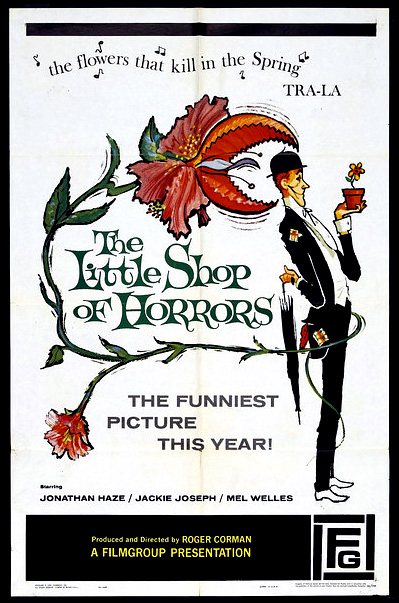
It is no shock that Joe Bob Briggs, a Roger Corman super-fan, has high praise for the film. He provided several great details about the production and crew, but the night’s theme was mostly a tribute to Roger Corman, who served as the final guest of the season. Corman stuck around for both films, and his interviews were fascinating, particularly when it came to the craft of film production. It just seems like further evidence Joe Bob needs a second show where he talks to talent.
One of the best bits from the host segment revolved around just exploring how influential Corman was. He is a modest man, so Joe Bob had to do a lot of the direction of the conversation in that regard, seeding stories for Roger to build on. The stories, though? Incredible, such as Roger’s experiencing taking acting classes and the ridiculous number of contacts he established by taking those classes.
The Little Shop of Horrors is a classic film and an important piece of film history. It is not without its problems, however. Those problems made the film a bit more charming and ultimately allowed Frank Oz’s later adaptation to do its own thing – and quite well. They’re two different experiences grown in the same soil, but each stands on its own. Joe Bob Briggs gave The Little Shop of Horrors four stars, which is a fair, reasonable assessment of the movie. I am more of a fan of the musical, but I can recognize the original as the art it is. I still have some hangups regarding the film’s structure, but it’s definitely an objectively great film. I give it four and a half Cthulhus out of five.

Best Line: “Now, no Novocain. It dulls the senses.” – Wilbur Force, Jack Nicholson’s kinky dental customer.
Humanoids from the Deep (1980)
When is Charlie Tuna going to get his comeuppance for rampant sex crimes?#thelastdrivein @therealjoebob @kinky_horror @shudder— Haunted MTL 🏳️🌈 (@HauntedMTL) June 19, 2021
Opening: Building on the energy of The Little Shop of Horrors… we’ve slowed down as a society.
Ah, Humanoids from the Deep. We are firmly in the Roger Corman production era, and perhaps Roger at his absolute heights as a figure in the industry with this film. Is it the best of the films Roger Corman produced under New World Pictures? Not really. But it is enjoyable and a great slice of what ended up a career retrospective for this evening on The Last Drive-In. The film has all the ingredients necessary for a Drive-In movie and absolutely delivers on all three fronts: blood, breasts, and beasts.
Humanoids from the Deep (or, MONSTER!) is a 1980 science fiction horror film starring Doug McClure, Ann Turkel, and Vic Morrow. Like many movies that show up on the show, this one had a trouble production: the film is nominally directed by Barbara Peeters, but Jimmy T. Murakami’s uncredited contributions are the behest of Corman. The screenplay was written by Fredrick James, based on a story by Frank Arnold and Martin B. Cohen, who served as a producer as well. Another credit of note, the music was handled by none of than James Horner.
The movie follows the local fisherman and community of Noyo, California. They are menaced by brutally escalating assaults by mysterious assailants who turn out to be murderous, raping fish-men from a nearby fishing company. Also, there is a subplot about indigenous cultures being abused by settling whites, themes of environmentalism, and small-town toxicity. There is also a bizarre scene with a puppet. It’s a great movie for Drive-In Mutants. For the normals? Not so much.
The plot is pretty loose, really only stretching a thin story over a few scenes of monstrous encounters. Nothing about the story itself comes off as surprising, either. It’s all very much in line with other films with the same sort of themes, but coming into Humanoids expecting something revolutionary in the narrative is a fool’s errand. Instead, the appeal from the film comes from the discrepancy between the actors and the material, the effects, and the unique way the monsters are handled.
The performances in the film are good, generally, and great surprisingly often. Given the nature of the film, some level of trickery was employed to get the scripts passed from the agents to the actors, and Roger confirmed as much in the show. Specifically, the film was pitched as a “psychological drama,” which is fantastic because that is so not what this movie is. But because a payday is a payday, the actors put their all into it. The performances range from the oddly compelling, if not a bit basic Doug McClure, to the incredibly compelling in Anthony Pena’s Johnny Eagle, to the ridiculously cartoonish villainy of Vic Morrow as Hank Slattery. The fact these actors put so much effort into this movie about killer fish-men snatching up women and slashing up men is astounding.
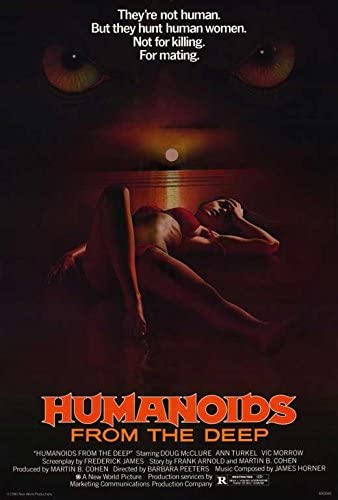
Oh, and those fish-men are amazing. A sizeable chunk of the film’s $2.5 million budget was wisely spent on the monster costumed by the legendary Rob Bottin (The Thing, RoboCop, The Howling). The monsters are damn good, especially when they emerge from the water. They also hold up incredibly well in a few underwater scenes. They are inevitably a bit goofy looking, as they are bipedal mutant salmon, but the elongated arms and strange features are the scary sides of goofy.
The movie, really, is all just set up from the final twenty minutes or so, featuring a massive attack on a local festival by the fish-men. It is a tight little film at under 80 minutes, but the story is mostly treading water until the attack. The film also, and perhaps most novelly, shows the monsters early on. Most creature features obscure the monster until the end. With Humanoids from the Deep, you’ll have seen at least a couple of the monsters in full during graphic sexual assaults or bloody slashing by the end of the first third of the film.
Joe Bob’s host segments continued to pull great anecdotes out of Roger Corman, especially on whether people can still produce films his way in today’s industry. To summarize Roger’s exquisite point: it’s hard today but still possible. Most of the other segment highlights were the increasingly absurd “six degrees of Roger Corman” reveals that emphasize his importance to cinema as a whole. Gale Anne Hurd? Martin Scorsese? Roger had a hand in shaping their careers. It’s astounding, really.
Humanoids from the Deep isn’t what you could call a great film, but it is a great movie if we believe such distinctions exist. Humanoids is entertaining and has a certain limited cultural relevance, but it’s not for everyone. This one is for the Mutants. By that assessment, Joe Bob Briggs’ four-star rating makes sense. I swim in a bit of a different stream in my reviews, though. I think it is a ton of fun and one I’d watch again and again, but it’s not one I would argue is great. I’d give it about three and a half Cthulhus.

Best Line: “Oh, come on, show me more than the head.” – Becky, talking about a ventriloquist dummy.
Haunted MTL Drive-In Totals
Our final drive-in totals of the season. I miss them already.
Shot in two days and it earned a four-star rating from @therealjoebob. We wouldn’t have it any other way. #TheLastDriveIn pic.twitter.com/aSlYbniEX6— Shudder (@Shudder) June 19, 2021 When the FX are done by Rob Bottin (The Thing, Legend), that’s an automatic 4-star rating. Them’s the rules. #TheLastDriveIn pic.twitter.com/5ueqHG3H6O— Shudder (@Shudder) June 19, 2021
As for our totals:
- 2 day shoot
- 4 Yuki Sightings
- 6 Degrees of Roger Corman
- 9 gym rules
- 14 dead dogs this season
- 67 years of Roger Corman films
- Flower Eating
- Self Medicating
- Vulture Joking
- Rapid Fire Dialogue Fu
- Self-financed Fu
- Darcy Cosplay: Audrey (the 1986 version), and a Humanoid… from the Deep!
- Silver Bolo Award: Good Bad Flicks
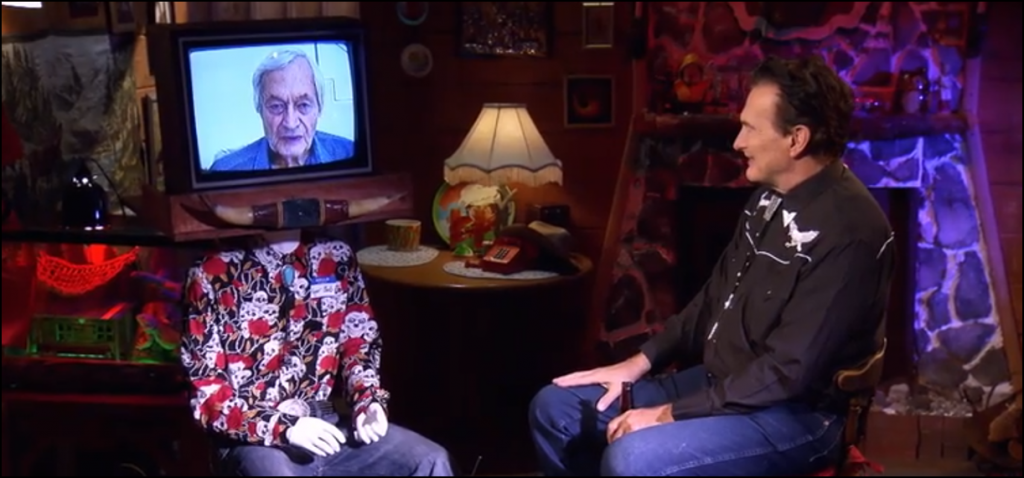
Episode Score
Tonight seemed to be the end to what I hope will be dubbed the “Cabin in the Woods”-era of the show, which means I also hope we’ll have multiple eras of The Last Drive-In. I know my criticisms of the isolation of the cabin set and some remote guests have been a running theme through my reviews of the season and the previous specials. Still, I ultimately feel this will be a nostalgic chapter of our collective Drive-In experience. It’s interesting how seeing Joe Bob and Darcy (in Humanoid cosplay) evokes that nostalgia, which of course, is the overall reason why Mutants tune in week to week to watch the show on Shudder, to begin with. Nostalgia, whether drawn from movies we know, or even the comforting presence of a guy in a bolo tie drinking beer and waxing wise about a movie, is something that we needed to get through the last year or so.
So, I guess while I had my gripes with the cabin, I am ultimately going to miss it. Funny how that will work – there will be the inevitable nostalgia. I think we’re going to be able to continue building memories of the show for a while to come. The slickly-produced Drive-In Oath between the two films felt like something you would produce for a show you plan to keep around, not send-off. Time will tell. Regardless, as with every season and special, we come to a close with a wistful Joe Bob and something that can work as the last Last Drive-in.

Lastly, if you want a little more Joe Bob while you wait for the next special, consider Join Darcy’s Patreon, The Lost Drive-In. I am a member and have already received a great Blu-Ray full of great Joe Bob bits from his previous shows. She also posts fun clips from the archives on show nights, so there is a ton of stuff you can enjoy.
Has anyone tried bonding with one of the Humanoids? Maybe they just need a little kindness.#thelastdrivein @therealjoebob @kinky_horror @shudder pic.twitter.com/Dkz7QRxzrN— Haunted MTL 🏳️🌈 (@HauntedMTL) June 19, 2021
David Davis is a writer, cartoonist, and educator in Southern California with an M.A. in literature and writing studies.

You may like
We have come now to the finale of season four of The Boys. And while it didn’t have the literal blood fireworks I wanted, someone did get ripped in half in the air. So, that’s pretty close.
As a note, I will try to avoid spoilers as much as possible. This ending was a hell of a gut punch that should be experienced as blindly as possible. That being said, I will not be able to avoid spoilers and still give a full legitimate review. Proceed at your own risk.
The story
The main storyline for this episode is the attempted assassination of President-Elect Robert Singer. The Boys join forces with the Secret Service to protect him. But, as we learned last episode, Annie has been replaced with a shapeshifter. A shapeshifter that was welcome not just into Hughie’s anus, but into the protective bunker in which the President-Elect is hiding.
What worked
The first thing I want to discuss about this episode is the ending. But we need to do this carefully.
The important thing here is that the ending breaks your heart on so many levels. So many terrible things are happening to characters that it’s almost hard to keep track. And each moment is significant to each character.
I cannot give a specific example. But no matter who your favorite character is, you’re going to weep for them.
Unless your favorite character is Sage. And this is the next thing that made this episode so fantastic.
I don’t think I’m spoiling anything to say that Sage’s plans worked out exactly as she wanted them to. And she got exactly what she wanted.
What she wanted wasn’t power. It wasn’t money or fame or vengeance. It wasn’t to win the love of anyone. She just wanted to see if she could do it.
That is a terrific, terrifying motivation! Because all she wants is to play a massive game of chess with people as pieces. She doesn’t care about anyone. She just wants to see how many people she can manipulate. She just wants to set things on fire to see if she can.
Fantastic. A plus villain work.
The next thing I want to discuss is a cornerstone of the whole series.
The morality of The Boys shifts through the series. While it’s very much a battle to save the world from overpowered super monsters, it’s also a battle for the souls of our real heroes. And in that battle, there are two warring factors. We have Hughie, always trying to bring everyone up to a better level. And we have Butcher, who has no problem at all hitting rock bottom with a shovel in hand to do some more digging.
In this episode, we saw almost every member of The Boys challenged. Will they rise to their higher angels, or sink with their demons?
On a similar note, I am so glad that the writers kind of addressed my issues with Annie. They did this by having the shapeshifter get right into her face and accuse her of thinking that she’s better than everyone.
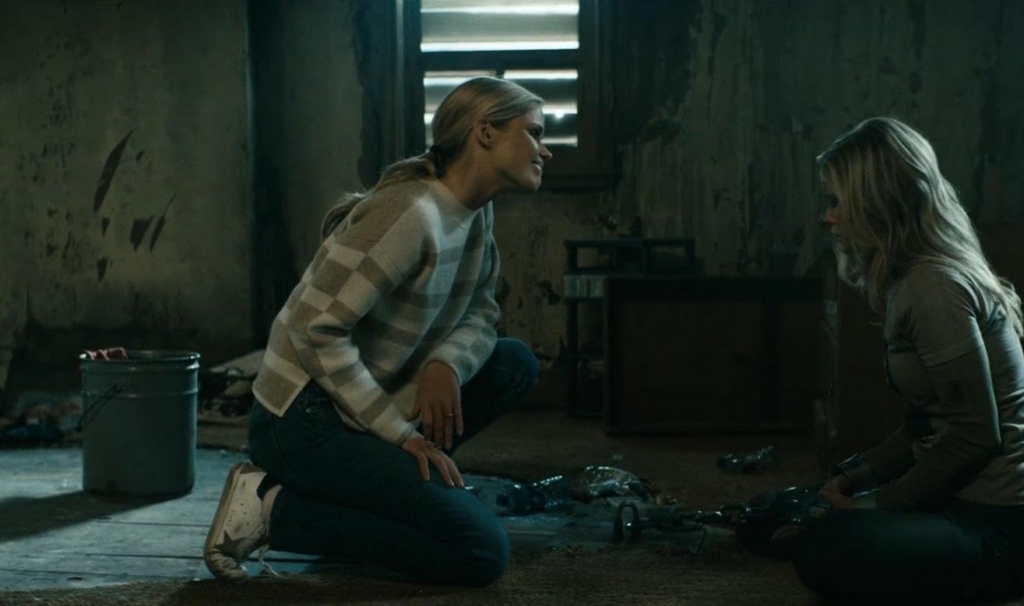
While that was devastating for the character, it was a little cathartic for those of us who felt like Annie was a little too good of a good guy.
What didn’t work
This is a small matter, but it is an issue that I want to address. After Annie finds out that Hughie slept with her doppelganger, she is furious at him.
In addition to this being unfair, it’s also a very cliche element to add. In almost every instance of a lookalike in fiction, there’s a moment where the love interest of the victim is fooled. Or almost fooled. And it’s always the same fight. It’s just played out and predictable. I’m just glad that it didn’t last very long.
Now that we’ve come to the end of the season, I can officially say that it was amazing. The story was deep and rich. The special effects were a stomach-turning good time. The character development was spot-on and satisfying. And, of course, it left me just about gagging to see what happens next. Unfortunately, it looks like we’ll have a bit of a wait. Because as of right now, the fifth season isn’t expected until 2026.

We’ve reached the second to last episode of The Boys, season four. And, as is appropriate for the penultimate episode of any show, things have to get a lot worse before they can get better.
Let’s discuss.
The story
Christmas is coming, and the whole world is getting ready. Ryan, despite being very clear that he didn’t want to appear on any TV shows or movies, has been strong-armed into participating in a Vought puppet Christmas special. He draws the line, though, when asked to sing about turning one’s parents in if they start talking about woke things.
Meanwhile, The Boys are trying to keep each other together. Butcher decides to take Sameer to the rest of the team. He also gets Frenchie out of prison, hoping they can make the Sup virus necessary to finally take down Homelander. Instead, this decision means disaster for one member of the team.
What worked
I first want to talk about Ryan’s speech near the end of the episode. Because it was exactly the moral of this whole story.
Ryan’s dad is a monster. His stepdad is also kind of a monster. But Ryan is a good kid. He cares about people, about family. And while he loves Homelander and Butcher, he doesn’t want to be like them.
Even better, this speech sounded like something a kid would say. Ryan didn’t open his mouth and start sounding like a college student all of a sudden. He sounds like a kid who misses his mom and wants to live up to the good standards she set for him. And I think that’s terrific.
Speaking of Homelander, he shot himself in the foot in this episode. I said earlier in the season that his hubris was going to be his downfall, and I was right. Without Sage, he just has the same weaknesses he’s always had. He’s going to fail because he just isn’t clever enough or patient enough to succeed.
Without Sage, I think a win is in the bag for The Boys. This isn’t to say that Homelander by himself isn’t dangerous. It’s just that he’s more like a wildfire than a controlled burn. He’s going to cause a lot of damage, but not get anything he wants out of it.
More’s the pity for him and everyone else who has to share his world.
Finally, I am thrilled with A-Train’s redemption story. I love that he wants to be a good person not to save himself, but to be a good person. His honest, pure and warm reaction to that little kid smiling at him in the last episode was heartwarming. It changed him in a moment, bringing to light a goodness that he’s been keeping under wraps for a long time.
This, along with Ryan’s courageous speech, proves once again what The Boys does so well. Yes, it’s gruesome. Yes, there’s blood and balls and batshit events. Yes, someone occasionally gets ripped in half. But there is a true human goodness in the story. One that we catch glimpses of. There are good people among the monsters. There is hope for redemption.
What didn’t work
Of course, so few things in this life are perfect, and this episode was no exception. For instance, I was irritated by the insinuation that Butcher cheated on his wife.
That just doesn’t make any sense. We’ve seen flashbacks of Billy and Becca. They were happy. He was happy. He was head over heels for her. And I don’t think it’s realistic or necessary for the character to throw in that he cheated. It does nothing to add to the story, it’s just a weird and offputting moment.
Doesn’t Butcher have enough to hate about himself? Can’t we just give him that at least he was a good husband?
Finally, I kind of hate that we ended up with Annie being caught. It’s just cliche, which is something I don’t normally say about this show. It feels lazy unless they do something very clever with it in the last episode. Which, I suppose, they might.
Next up is the season finale. And with this season being as insane as it has been, I’m expecting nothing short of bloody fireworks. And I mean literal fireworks of blood. At this point, would it surprise anyone?
 (4 / 5)
(4 / 5)
Episode six of The Boys was one of the most surprising episodes of the series so far. And that is certainly saying something. Because this season has so far been bonkers.
The story
Our episode today revolves around a party at Tek Knight’s lovely mansion. Yes, it does look just like Wayne Manor.
The Boys know that Tek Knight is working with Homelander on something, but they don’t know the details. So they decide to send Hughie in to bug the mansion.
Because that’s worked so well the other two times he’s tried to hide a bug!
It should surprise no one that this time goes no better. Hughie finds himself in Tek Knight’s basement. And by that I mean his BDSM dungeon.
Meanwhile, the party upstairs is no less disturbing. Homelander and Sage are trying to convince some well-off political donors to support a cue after the election. When pressed for details on his plan, Homelander freezes. He looks to Sage for help, but she wasn’t recently shot in the head and still in the junk food stage of her healing.
Fortunately, or unfortunately depending on your point of view, Neuman jumps in and saves the day.
What works
If I’m going to say one thing about this episode, it didn’t hold back at all. I didn’t expect them to show a character masturbating, sitting their bare behind on a cake, or spraying breastmilk into someone’s face. But every time I thought they’d cut the scene and let something be left to our imagination, they did not do that.
This is a dangerous move. Whenever you show the monster, you run the risk of them not being scary enough, or gross enough. As Stephen King says in Danse Macabre, to leave this sort of thing to the imagination if the reader makes things so much worse. So when they finally experience the monster, they might say that this isn’t so bad. It could have been so much worse.
But in this case, they managed to avoid that by making the scenes, especially the ones in Tek Knight’s dungeon, so much worse than I imagined it would be.
What doesn’t work
While this was a deeply disturbing episode in many ways, there was one really innocent and sweet moment.
And yes, I did have a problem with it.
Confronted by Firecracker, Annie decides to apologize for spreading rumors about her when they were kids. She tells her that she is genuinely sorry.
And I believe her. I don’t think Firecracker did, but I did.
So why is this an issue? Because I’m starting to think that Annie is maybe too nice. She is too good.
I know that Annie is our good guy. But every one of the other good guys has flaws. Hughie let his pride get in the way and took Temp V. MM hid himself from his daughter instead of teaching her to work through her emotions. Kimiko is far too closed off and has a hard time trusting others. Frenchie numbs himself with drugs. And well, what hasn’t Butcher done?
It is unrealistic that Annie is just so kind and so flawless. We all have shadows in our personalities. We all have weaknesses, we all mess up. We all do things we wish we could take back. The fact that Annie doesn’t seem to have anything like that is not just unrealistic. It’s infantilizing.
Give her some deep dark secrets. Give her something real to regret.
This was a shocking episode, even for someone fairly jaded like me. I wasn’t expecting the sort of weird sexual depravity, though I guess maybe I should have seen it coming. It was dark, upsetting, tense, and funny as hell. And with just two episodes left in the season, I can imagine the stakes are only going to get higher.
 (4 / 5)
(4 / 5)
By the way, if you like my writing you can get my short story, Man In The Woods, on Smashwords and Amazon.

